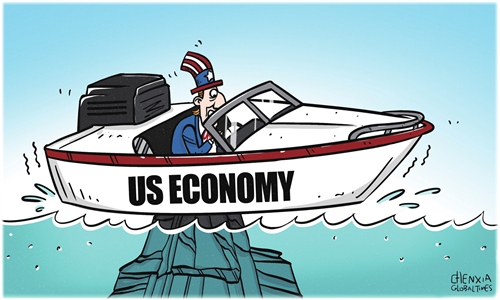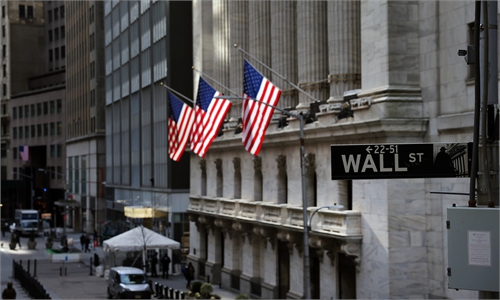
A view of the Amazon logo. Photo: VCG
US e-commerce giant Amazon has made history as the world's first public company to lose $1 trillion in market value amid a tech stock rout in the US, Bloomberg reported on Thursday.
Shares of the firm fell 4.27 percent on Wednesday, dragging its market capitalization to about $879 billion from a record market value of $1.88 trillion in July 2021. It came just days after sell-offs in the company took its market cap below $1 trillion for the first time since April 2020.
From a micro perspective, the rapid plummet in Amazon's market value is due in large part to its poor business performances. Specifically, Amazon's e-commerce sector delivered sluggish earnings results for three quarters in a row this year. In its third-quarter earnings report, Amazon reported a decline of more than 9 percent to $2.9 billion, with most key financial indictors falling short of market expectations.
Moreover, the firm also made disappointing fourth-quarter forecast, projecting that sales revenue during the holiday quarter might slow to as low as 2 percent, far below analysts' estimates. Given such a dim outlook, Amazon's share prices have gone into a downward spiral.
However, from a macro perspective, as a US-based e-commerce giant, Amazon's predicament offers certain indication of acute structural problems faced by the US' e-commerce sector as well as the US economy as a whole. After all, what's behind Amazon's sluggish sales performance is shrinking online consumption by US consumers. Because of the global economic downturn and the gloomy macro-economic environment with rising inflation and tightening monetary policy, the purchasing power of US consumers have clearly been affected.
Also, it is important to note that one of the most critical factors undercutting Amazon's performance is that consumers who had made purchases online during the COVID-19 pandemic have resumed the pre-pandemic habit of buying at offline stores, a development that actually points to the bottlenecks facing the development of the e-commerce sector in the US.
Moreover, beyond the shifting consumer habits and declining consumption, the problems facing Amazon and the US' e-commerce sector is that it doesn't have the sufficient support it needs for development from the real economy and logistics system. This could serve as a reminder of the importance of the real economy and why China still needs to prioritize developing the real economy.
For example, it goes without saying as to whether Amazon sells more products made in the US or in China. Without the support of massive "made in China," Amazon would not become the largest e-commerce platform in the US. This is because the Chinese manufacturing sector has large-scale production capacity in the consumer goods sector, therefore what Chinese manufacturers produce will surely be welcome by the market for its good quality and affordable prices. What's behind the rise of Amazon's e-commerce business is the mass inflows of low-cost goods made in China.
Fundamentally speaking, the rise of the US e-commerce sector is inseparable from globalization, which is actually a typical example of the US economy sharing the dividends of the Chinese manufacturing development.
Nevertheless, the US government doesn't seem to recognize this simple truth. Instead, Washington has tried to defy the economic laws by focusing on bringing manufacturing back to the US. But can some policies or incentives simply help the US build a manufacturing for mass production? And what can US e-commerce platforms like Amazon use to maintain the appeal to consumers if they lose the support of China's manufacturing sector under the US' decoupling push from China's supply chains? The e-commerce industry needs to give it a think.
Meanwhile, it is the structural problems of the US economy, which has deviated too far away from the real economy, that has precipitated the decline of its hegemony. Domestically, these structural problems have led to a more serious wealth gap in the US, adding to social class solidification and political division. Internationally, its consequent abuse of the dollar hegemony has exported inflation, dragging many economies into recession.



